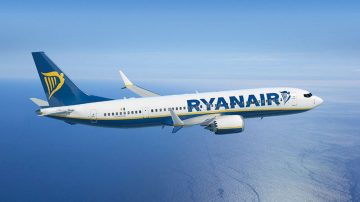
What is fit for 55?
‘Fit for 55’ is a package of reforms from the European Union which aims to reduce emissions by at least 55 per cent from 1990 levels by 2030.
The proposals affect a range of sectors such as construction, energy and transport, including aviation.
For aviation, the main changes are:
- The revision of the EU Emissions Trading System
The proposal:
The EU Emissions Trading System (ETS) is a carbon market-based measure (CBM) to control greenhouse gases. EU ETS puts a price on carbon and lowers the cap on emissions from certain economic sectors every year. At the moment aviation has some free allowances, but these would be phased out between 2024 and 2026 (by respectively: 25 per cent, 50 per cent and 75 per cent ) with a complete phase-out from 2027 onwards.
The EU ETS would continue to apply to intra-EEA flights as well as flights to the UK and Switzerland, exempting those flights from CORSIA offsetting requirements. For other international flights, EU airlines would be obliged to apply CORSIA.
What the airlines say:
CORSIA obliges airlines to purchase verified carbon offsets to cover emissions increases above a baseline level and applies to all international flights between countries participating in the scheme. At present, EU airlines do not comply with CORSIA for international flights between European States because the EU applies the EU ETS rather than CORSIA. The failure to apply CORSIA undermines multilateralism in ICAO on climate change. CORSIA’s scope and environmental effectiveness is considerably wider than that of the EU ETS. For example, the EU has no jurisdiction to apply its ETS to a flight between Japan and the United States, whereas that flight would fall under CORSIA. The EU is risking the international consensus for CORSIA and potentially causing the collapse of the world’s first and only sector specific MBM. The Commission should propose to implement CORSIA in the EU. This would put the EU in a position to lead the debate on a long-term governmental goal for international aviation emissions that will match the industry’s own target of net-zero emissions by 2050. (IATA.org)
In addition, “European airlines are very concerned about a premature phase-out of free ETS allowances for the sector. The numbers in question are significant. In 2019, EU airlines spent EUR 950 million on ETS compliance, having to purchase certificates for 60% of their emissions at a price of EUR 25 per ton. Buying allowances for 100% of 2019 emissions at today’s carbon price of over EUR 80 per ton would amount to compliance costs of EUR 5.2 billion annually. Costs may well reach EUR 6 billion by 2025, even as aviation emissions fall. The industry will not have the means to internalize these costs in the wake of the COVID-19 crisis.” (Airlines4Europe)
- ReFuelEU Aviation (to increase use of SAF)
The proposal:
ReFuelEU Aviation will require fuel suppliers to blend an increasingly high level of sustainable aviation fuels into existing jet fuel uploaded at EU airports, including synthetic low carbon fuels, known as e-fuels. In July the EU Parliament said that from 2025, this share for SAF should be 2 per cent, increasing to 37 per cent in 2040 and 85 per cent by 2050 (the Commission had proposed 32 per cent for 2040 and 63 per cent for 2050).
There will also be an obligation on all airlines (EU and non-EU) departing from EU airports to uplift the jet fuel necessary to operate the flight prior to departure, to avoid fuel tankering. The proposal o calls for Member States to introduce penalties on aviation fuel suppliers and aircraft operators in case of non-compliance.
What the airlines say:
Airlines used every drop of the 100 million litres of SAF that was delivered in 2021 and thanks to billions of dollars in forward purchase agreements from airlines, more SAF producers are entering the market and we expect SAF production to expand over the coming years. The problem with the mandate is approach is that it forces all airports to source SAF which will lead to logistical issues, localized monopolies, and excessive costs. Instead airlines should be allowed to buy SAF from wherever it is cheapest. It is also environmentally inefficient to insist on transporting SAF to almost every airport in Europe. This problem could be addressed through a flexibility mechanism that separates the physical use of SAF from the sustainability gain claimed by the airline (‘Book and claim’). This will drive greater efficiency, reduce costs, and encourage more production. There is also the problem of the geographic scope of such a mandate. If applied to all international flights leaving the EU, this could simply benefit non-EU airlines that can refuel at non-EU airports with no SAF mandate. The difference could amount to around €42 per passenger on a typical Europe-Asia flight. (IATA.org)
- The Energy Taxation Directive
The proposal:
This is, effectively, a tax on jet fuel, though viewed another way, it is a removal of jet fuels current tax free status (most transport fuels are taxed) as part of a removal of all fossil-fuel subsidies. From 2023, the minimum tax rate for aviation fuel for intra-EU flights would start at zero and increase gradually over a 10-year period. SAF would be exempt, as would cargo-only flights.
What the airlines say:
By increasing the costs to the industry such a tax diverts resources that could otherwise be dedicated to investments in green technologies. European airlines have finite financial resources, so “measures which increase airlines’ costs well ahead of the time when alternative technologies become available on the market will not only fail to trigger carbon reductions but may well undermine our ability to decarbonise later.” (Airlines4Europe)












